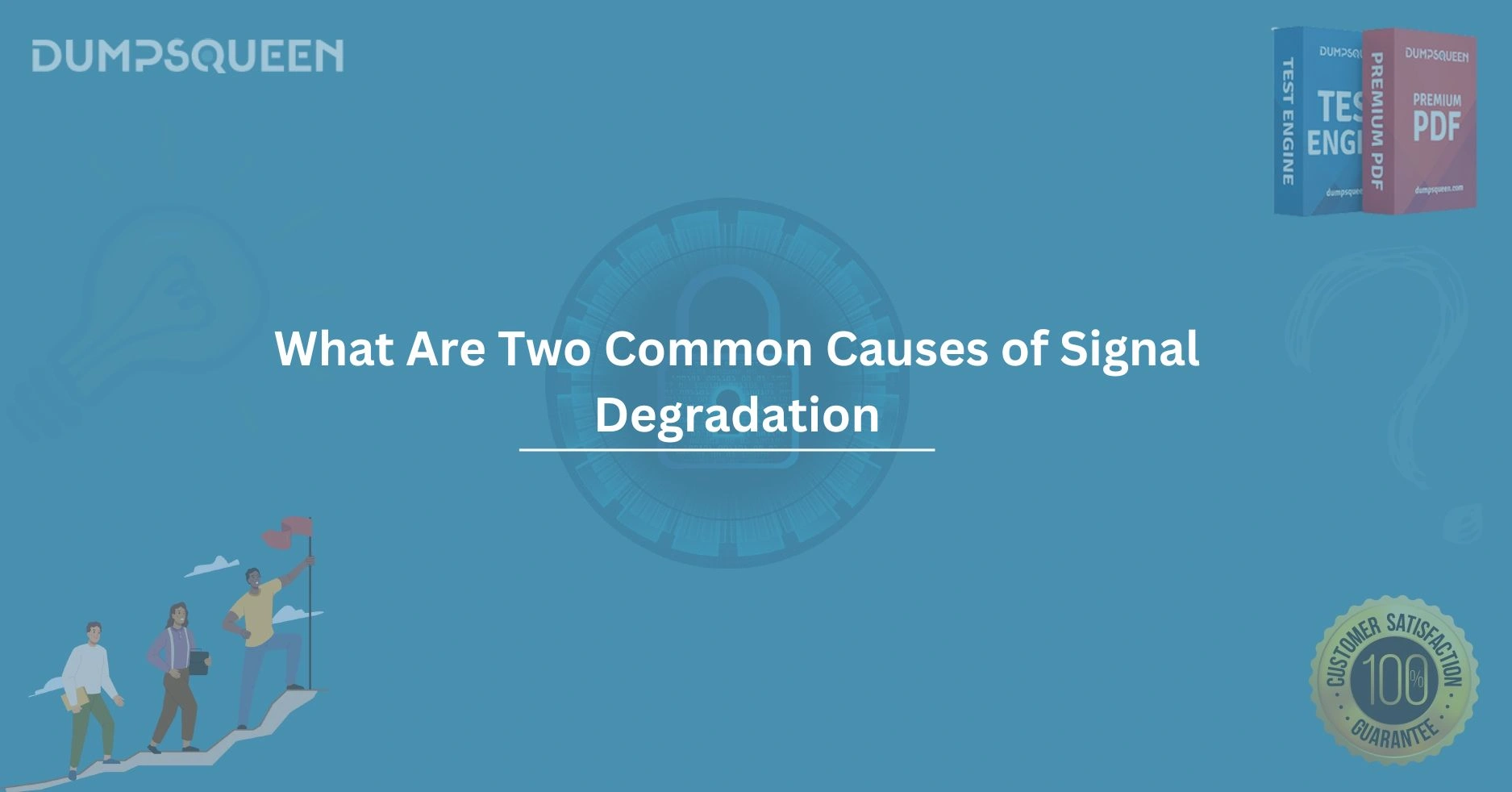Introduction
In today’s interconnected world, seamless communication and data transfer are the backbone of modern technology. From wireless networks to wired systems, the integrity of signals is critical to ensuring reliable performance. However, signal degradation—a phenomenon where the quality of a transmitted signal diminishes—can disrupt connectivity, slow down systems, and lead to inefficiencies. Understanding the causes of signal degradation is essential for professionals, engineers, and enthusiasts working in telecommunications, networking, and electronics. In this comprehensive guide, brought to you by DumpsQueen, we explore two common causes of signal degradation: attenuation and interference. By delving into the intricacies of these factors, we aim to equip you with the knowledge to mitigate their effects and optimize your systems for peak performance. Visit the official DumpsQueen website for more resources to enhance your technical expertise.
Understanding Signal Degradation
Signal degradation refers to the loss of quality or strength in a signal as it travels through a medium or a device. Whether it’s a voice call dropping, a video stream buffering, or a data packet failing to reach its destination, signal degradation is often the culprit. This phenomenon can occur in both analog and digital systems, affecting everything from radio waves to fiber-optic transmissions. The consequences of signal degradation include reduced data rates, increased error rates, and, in severe cases, complete loss of communication. To address this issue effectively, it’s crucial to identify its root causes. At DumpsQueen, we believe that knowledge is power, and understanding the factors behind signal degradation empowers you to troubleshoot and resolve issues with confidence.
Cause 1: Attenuation
Attenuation is one of the most prevalent causes of signal degradation across various communication systems. It refers to the natural reduction in a signal’s amplitude or intensity as it travels through a medium, such as a cable, air, or optical fiber. This phenomenon is an inherent property of signal propagation and cannot be entirely eliminated, though its impact can be minimized.
The Physics Behind Attenuation
Attenuation occurs due to the energy loss a signal experiences as it interacts with the medium. For instance, in a copper wire, electrical resistance causes some of the signal’s energy to dissipate as heat. In wireless communication, signals lose strength as they spread out over distance or encounter obstacles like walls and trees. Similarly, in fiber-optic cables, light signals weaken due to scattering or absorption within the fiber. The extent of attenuation depends on several factors, including the medium’s properties, the signal’s frequency, and the distance traveled.
Attenuation in Different Systems
In wired systems, such as coaxial cables or twisted-pair wiring, attenuation is influenced by the cable’s material and length. Longer cables result in greater signal loss, as the signal has more opportunities to dissipate. High-frequency signals, commonly used in modern high-speed networks, are particularly susceptible to attenuation because they lose energy more rapidly than low-frequency signals.
In wireless systems, attenuation is even more complex. Signals transmitted through the air encounter free-space path loss, where signal strength decreases with the square of the distance from the transmitter. Environmental factors, such as rain, fog, or foliage, further exacerbate attenuation by absorbing or scattering radio waves. For example, a Wi-Fi signal may weaken significantly when passing through multiple walls in a building, leading to slower internet speeds.
Real-World Implications
The effects of attenuation are noticeable in everyday scenarios. A mobile phone call may become garbled when you move too far from a cell tower, or a cable internet connection may slow down if the modem is connected to a long coaxial cable. In professional settings, attenuation can disrupt critical operations, such as data transfers in enterprise networks or signal transmission in satellite communications.
Mitigating Attenuation
Fortunately, there are strategies to counteract attenuation. In wired systems, using high-quality cables with lower resistance or installing signal amplifiers can help maintain signal strength over long distances. In wireless systems, deploying repeaters or strategically placing antennas can boost coverage. Additionally, choosing the appropriate frequency band for a given application can minimize attenuation, as lower frequencies tend to travel farther with less loss. At DumpsQueen, we provide resources and study materials to help professionals master these techniques and optimize their communication systems.
Cause 2: Interference
The second common cause of signal degradation is interference, which occurs when unwanted signals disrupt the transmission of the desired signal. Interference introduces noise or distortion, making it difficult for the receiver to accurately interpret the original signal. In a world filled with countless electronic devices and overlapping communication networks, interference is a growing challenge.
Types of Interference
Interference can be classified into several types, depending on its source and nature. Electromagnetic interference (EMI) is one of the most common forms, caused by electromagnetic radiation from devices like motors, power lines, or other transmitters. For example, a microwave oven operating near a Wi-Fi router can introduce EMI, leading to dropped connections.
Another prevalent type is radio frequency interference (RFI), which occurs when multiple radio signals operate on overlapping frequencies. In crowded urban environments, where numerous Wi-Fi networks, Bluetooth devices, and cellular signals coexist, RFI can significantly degrade performance. Co-channel interference, where two devices use the same frequency channel, and adjacent-channel interference, where signals on nearby frequencies overlap, are frequent culprits in wireless networks.
Sources of Interference
Interference can originate from both external and internal sources. External interference comes from devices or systems outside the intended communication path. For instance, a cordless phone operating on the same frequency as a Wi-Fi network can disrupt internet connectivity. Natural phenomena, such as solar flares or lightning, can also introduce interference in radio communications.
Internal interference, on the other hand, arises within the communication system itself. Crosstalk, a common issue in wired systems, occurs when signals from adjacent cables bleed into one another, causing distortion. In wireless systems, multipath interference can degrade signals when reflections of the same signal arrive at the receiver at slightly different times, creating constructive or destructive interference patterns.
Impact on Signal Quality
Interference degrades signal quality by introducing errors or reducing the signal-to-noise ratio (SNR). A low SNR means the desired signal is harder to distinguish from background noise, leading to dropped packets, slower data rates, or garbled audio. In critical applications, such as medical equipment or autonomous vehicles, interference can have serious consequences, underscoring the importance of robust interference mitigation strategies.
Strategies to Reduce Interference
Minimizing interference requires a combination of careful system design and proactive troubleshooting. Shielding cables and devices can block EMI, while selecting non-overlapping frequency channels can reduce RFI in wireless networks. For example, configuring Wi-Fi routers to use less congested channels (e.g., 1, 6, or 11 in the 2.4 GHz band) can improve performance in crowded areas. Advanced technologies, such as spread-spectrum modulation or error-correcting codes, also help systems resist interference.
Environmental planning is another key factor. In wireless deployments, avoiding physical obstructions and spacing antennas appropriately can reduce multipath interference. For wired systems, using twisted-pair cables or fiber optics can minimize crosstalk. By leveraging the resources available on the DumpsQueen official website, professionals can gain the skills to implement these solutions effectively.
The Broader Context of Signal Degradation
While attenuation and interference are two of the most common causes of signal degradation, they often interact with other factors to create complex challenges. For instance, a signal weakened by attenuation becomes more susceptible to interference, as its reduced strength makes it harder to distinguish from noise. Similarly, environmental conditions, such as temperature or humidity, can exacerbate both issues by altering the properties of the transmission medium.
Addressing signal degradation requires a holistic approach that considers the entire communication system. Engineers must balance factors like cost, performance, and reliability when designing networks or troubleshooting issues. By understanding the root causes—attenuation and interference—you’re better equipped to anticipate problems and implement solutions before they escalate.
Conclusion
Signal degradation is a pervasive challenge in communication systems, but understanding its causes empowers you to take control. Attenuation and interference, two of the most common culprits, can significantly impact the performance of wired and wireless networks. By recognizing how attenuation weakens signals over distance and how interference introduces unwanted noise, you can implement targeted solutions to maintain signal integrity. From selecting the right equipment to optimizing frequency channels, the strategies discussed in this guide offer practical ways to combat signal degradation.
At DumpsQueen, we’re committed to helping you excel in your technical journey. Whether you’re a seasoned engineer or an aspiring professional, our resources on the official DumpsQueen website provide the tools you need to master complex concepts and stay ahead in your field. By addressing signal degradation with knowledge and precision, you can ensure reliable, high-quality communication in any system.
Free Sample Questions
1. What is attenuation in the context of signal transmission?
a) The introduction of unwanted signals into a transmission
b) The reduction in signal strength as it travels through a medium
c) The complete loss of a signal due to equipment failure
d) The distortion caused by overlapping frequency channels
Answer: b) The reduction in signal strength as it travels through a medium
2. Which of the following is a common source of electromagnetic interference (EMI)?
a) High-quality shielded cables
b) A microwave oven operating near a Wi-Fi router
c) Low-frequency radio signals
d) Fiber-optic cables
Answer: b) A microwave oven operating near a Wi-Fi router
3. How can multipath interference affect wireless signals?
a) It strengthens the signal by amplifying its amplitude
b) It causes reflections of the signal to arrive at different times, creating distortion
c) It eliminates all forms of noise in the transmission
d) It reduces the signal’s frequency to improve clarity
Answer: b) It causes reflections of the signal to arrive at different times, creating distortion
4. Which strategy can help mitigate attenuation in a wired communication system?
a) Using longer cables to increase signal reach
b) Installing signal amplifiers to boost strength
c) Operating devices on overlapping frequency channels
d) Ignoring environmental factors like temperature
Answer: b) Installing signal amplifiers to boost strength



